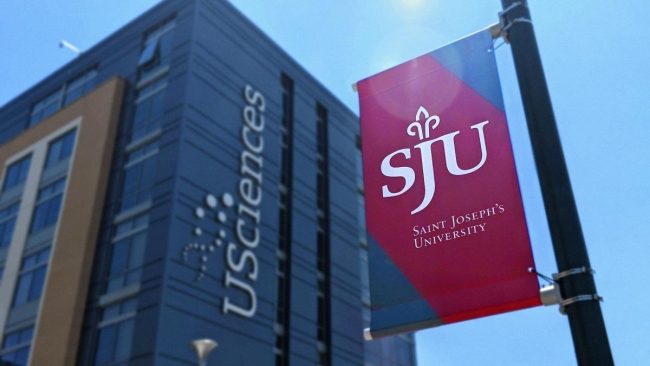You have /5 articles left.
Sign up for a free account or log in.

Saint Joseph’s University absorbed the University of the Sciences in a deal that adds numerous health programs to Saint Joseph’s academic offerings.
Saint Joseph’s University
On June 1, Saint Joseph’s University officially merged with the University of the Sciences, making the crosstown campuses one institution under the Saint Joseph’s name.
For Saint Joseph’s, absorbing the robust suite of health care offerings at the University of the Sciences allows for an immediate expansion of academic programs, drawing on the expertise of faculty members already on campus.
For the University of the Sciences, the deal offers continuity for students amid financial challenges in recent years that led both Fitch Ratings and Moody’s Investors Service to downgrade the institution as its endowment funds dwindled.
Now the two Philadelphia campuses share a joint mission. Officials at Saint Joseph’s believe such mergers may become the new normal as higher ed institutions contend with a number of challenges.
The Right Fit
Mark Reed, president of Saint Joseph’s, said the university’s strategic plan includes looking for opportunities to broaden its academic portfolio, which made the merger an attractive option.
“Now, we do that—just as every institution would do—normally through incremental changes, responding to market needs, etc.,” Reed said. “But we also were very clear in our strategic plan, given where we’re located in Philadelphia, given the region, given the number of institutions, that there may be opportunities to do something bigger and bolder, such as a merger or acquisition.”
No money changed hands to facilitate the merger, Reed noted, explaining that “Saint Joseph’s University is absorbing all of the assets and all the liabilities of the University of Sciences.”
Saint Joseph’s, a Jesuit college established in 1851, has a rich history as a liberal arts institution. University of the Sciences has long focused on health care professions. Founded in 1821, University of the Sciences was home to the first school of pharmacy in the U.S. Saint Joseph’s has upward of 6,500 students, while the University of the Sciences enrolled around 2,000.
While Saint Joseph’s already had some health-related programs, including various majors and a Center for Autism Education and Support, it didn’t have a college of health professions. Now it does, with established, accredited programs in areas like physical therapy, pharmacy and others.
Reed said there’s also potential for new programs or interdisciplinary growth.
But there was a certain degree of overlap between the two colleges—redundancies in certain areas. One example is athletics. Saint Joseph’s has a Division I athletics program, whereas University of the Sciences competed at the Division II level. Unable to operate multiple athletic departments at different levels of NCAA competition, Saint Joseph’s wound down the Division II program.
“It would be impossible to not have some redundancy, given the fact that both institutions were fully comprehensive institutions, top to bottom. So we have had some attrition, both in terms of academic staffing as well as administrative staffing,” Reed explained.
Saint Joseph’s retained 140 of 170 faculty members, providing severance for those let go. And some employees opted not to join Saint Joseph’s as it took over the University of the Sciences. Personnel decisions are still being made, with a number of moves to be settled over the summer.
Beyond the attrition, there have also been some culture clashes to navigate.
Before the completion of the merger, some University of the Sciences students expressed dismay to local media outlets that they wouldn’t be able to obtain birth control from Saint Joseph’s, a Catholic institution. University of the Sciences said as much via email in late April: “Effective 6/1/2022, student health will no longer be permitted to prescribe or dispense birth control pills, any type of birth control, or condoms once we merge with SJU,” the announcement read in part. “This is in accordance with Catholic doctrine which they abide by strictly.”
But access to birth control seems to be an organizational matter, not a doctrinal one.
“Saint Joseph students today can access birth control, so Saint Joseph’s University students tomorrow can access birth control. The university does not dispense it, we don’t dispense it from a campus pharmacy—we don’t have a campus pharmacy,” Reed said, adding that Saint Joseph’s does not restrict access to birth control, which is covered by health insurance plans.
The Future of Mergers
As Saint Joseph’s navigates a new arrangement, it will do so with a new interim president in Cheryl McConnell, who is currently the provost and vice president for academic affairs.
“This is an example of a merger/acquisition that’s going to become far more common in higher education,” McConnell said. “We all know that smaller and specialty institutions are going to continue to struggle. But this was not a merger of a university that was one step away from closing its doors, and it’s rather unique in that way. I think that’s going to become far more ubiquitous in higher education in the future. And I think that the path that we’ve laid here can be useful for other institutions that are considering the same thing.”
Reed, who is leaving in August to take the helm of Loyola University Chicago, seconds the notion that this type of merger will become more common across higher education in the years to come. He encourages universities to be open to such expansion opportunities when they arise.
David King, a management professor at Florida State University who studies mergers and acquisitions, notes some of the same advantages that Saint Joseph’s officials highlighted. This type of merger, he explained, offers the benefit of adding new academic programs immediately.
“The primary advantage of acquiring is speed, or they provide existing capabilities immediately. Universities in similar locations will typically differentiate, so buying a local competitor can combine complementary programs. Building a new academic program takes at least a couple of years to hire qualified faculty, design courses, and get them accredited,” King wrote via email. “This can all be avoided by adding established programs.”
Though often beneficial, mergers can also be risky, King said, noting that “most of the risk is during integration” as two organizations become one. Common challenges include turnover and additional risks of managing unfamiliar programs.
Mergers can provide complementary academic programs, certain cost efficiencies and stability for students at the college being absorbed, explained John MacIntosh, managing partner of SeaChange Capital Partners (and an Inside Higher Ed opinion contributor), which manages the Transformational Partnership Fund established by a number of higher ed organizations to help colleges explore collaboration options.
But mergers can also be tricky to navigate—and even pull off. For example, Marymount California University announced in April that it would close after a failed attempt at a merger with Saint Leo University. And even successful mergers can be painful for those involved. When the struggling Mills College announced it would merge with Northeastern University, alumnae groups at Mills, a women’s college, launched an unsuccessful legal battle, questioning the merger.
“I think what makes these discussions often challenging is that there are just so many constituents [students, faculty, staff, trustees, local community] who, quite rightly, even if they have the same set of facts, may not see things the same way,” MacIntosh said. “The thought that all those groups are going to be enthusiastic about a particular partnership is not realistic.”
But risks aside, MacIntosh said mergers are something colleges should remain open to, especially if market forces—such as enrollment challenges driven by demographics or other factors—put colleges in a position where they have to choose between merging or closing.
Beyond the shrinking pool of students going to college and therefore diminishing tuition revenue, King notes that dwindling endowments and decreased donations will exacerbate financial pressures.
Projecting college closures is a “fool’s game,” MacIntosh said, but given the trends in higher ed, especially for small private colleges, leaders need to think ahead.
“I think the fact is that a meaningful percentage of smaller private colleges do not see their current situation as sustainable in the medium term. That doesn’t mean they’re all going to go bust, it doesn’t mean they’re going to merge, but I think a meaningful percentage of smaller private colleges don’t see the way they’re configured right now as sustainable, financially or programmatically,” MacIntosh said. “If you’re leading a small private college, you should be thinking very hard about the current environment and thinking creatively about your options.”




